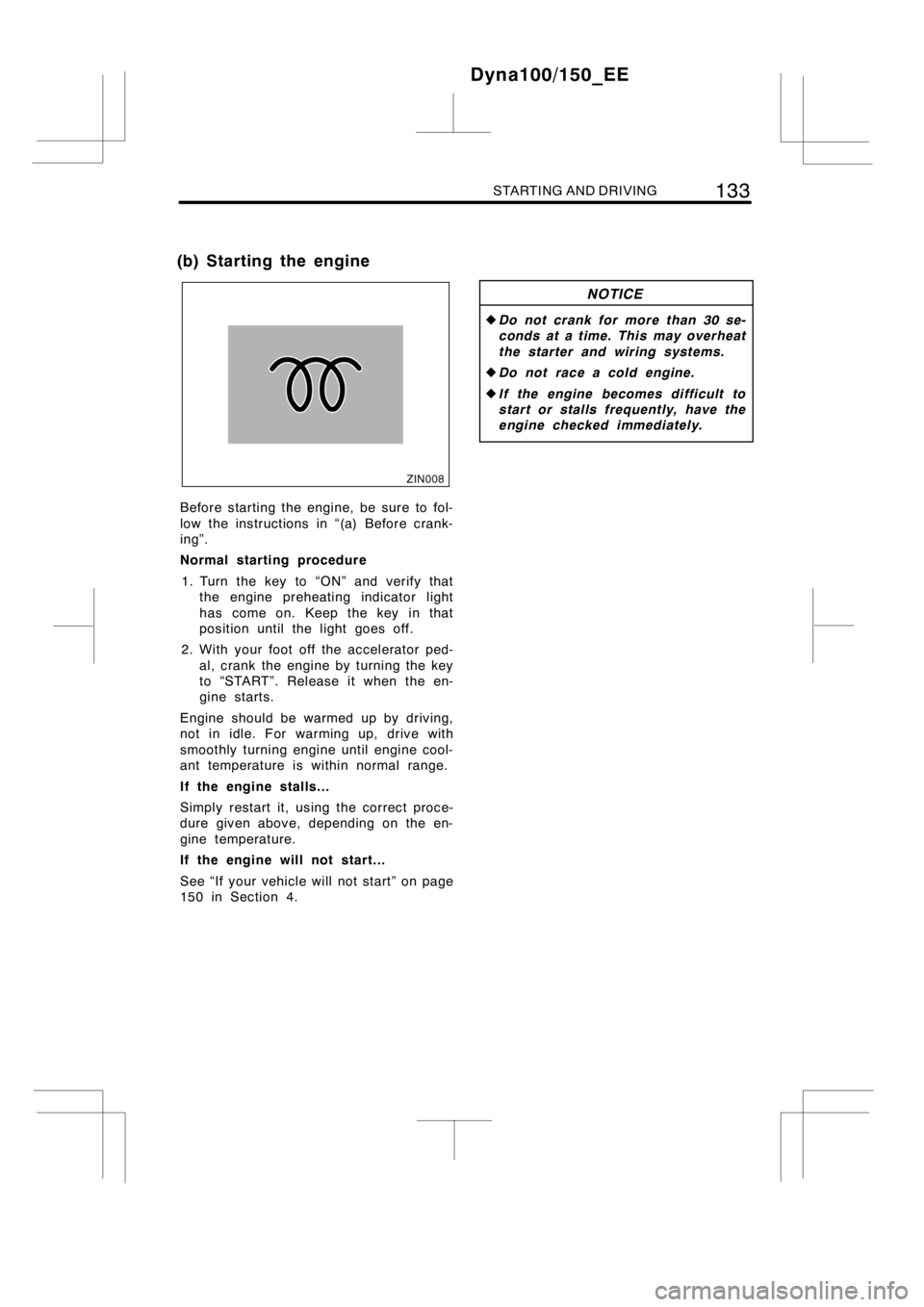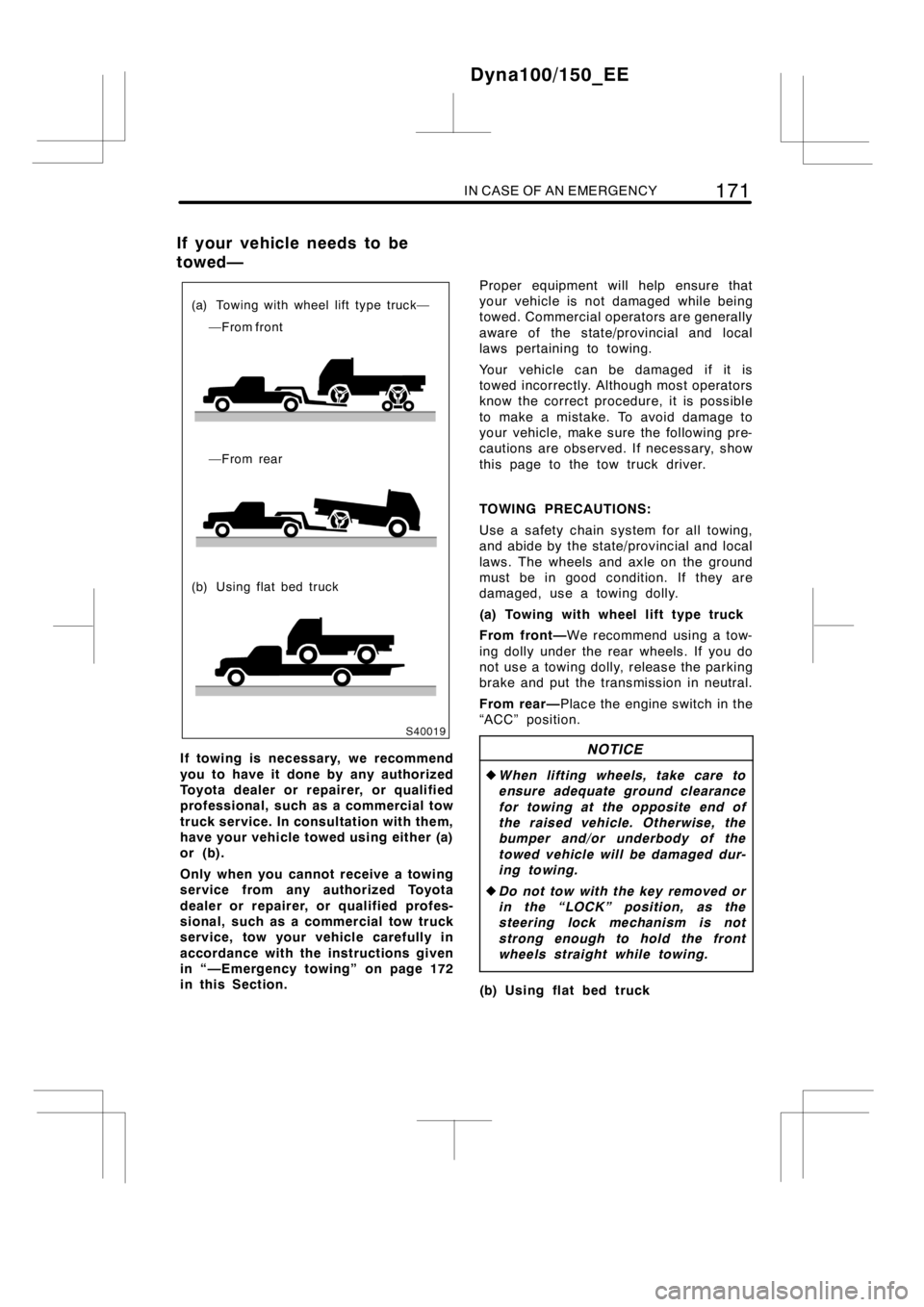2012 TOYOTA DYNA 100/150 key
[x] Cancel search: keyPage 139 of 240

STARTING AND DRIVING133
Before starting the engine, be sure to fol-
low the instructions in “(a) Before crank-
ing”.
Normal starting procedure
1. Turn the key to “ON” and verify that
the engine preheating indicator light
has come on. Keep the key in that
position until the light goes off.
2. With your foot off the accelerator ped-
al, crank the engine by turning the key
to “START”. Release it when the en-
gine starts.
Engine should be warmed up by driving,
not in idle. For warming up, drive with
smoothly turning engine until engine cool-
ant temperature is within normal range.
If the engine stalls...
Simply restart it, using the correct proce-
dure given above, depending on the en-
gine temperature.
If the engine will not start...
See “If your vehicle will not start” on page
150 in Section 4.
NOTICE
zDo not crank for more than 30 se-
conds at a time. This may overheat
the starter and wiring systems.
zDo not race a cold engine.
zIf the engine becomes difficult to
start or stalls frequently, have the
engine checked immediately.
Dyna100/150_EE
(b) Starting the engine
Page 144 of 240

138STARTING AND DRIVING
Keep the door locks from freezing.
Squirt lock de−icer or glycerine into the
locks to keep them from freezing. To open
a frozen lock, try heating the key before
inserting it.
Use a washer fluid containing an anti-
freeze solution.
This product is available at any authorized
Toyota dealer or repairer and most auto
parts stores or another qualified professio-
nal. Follow the manufacturer ’s directions
for how much to mix with water.
NOTICE
Do not use engine antifreeze or any
other substitute because it may dam-
age your vehicle’s paint.
Do not use your parking brake when
there is a possibility it could freeze.
When parking, put the transmission into
first or reverse and block the front
wheels. Do not use the parking brake, or
snow or water accumulated in and around
the parking brake mechanism may freeze,
making it hard to release.
Keep ice and snow from accumulating
under the fenders.
Ice and snow built up under your fenders
can make steering difficult. During bad
winter driving, stop and check under the
fenders occasionally.
Depending on where you are driving,
we recommend you carry some emer-
gency equipment.
Some of the things you might put in the
vehicle are tire chains, window scraper,
bag of sand or salt, flares, small shovel,
jumper cables, etc.Your vehicle is designed primarily as a
passenger−and−load−carrying vehicle. Tow-
ing a trailer will have an adverse effect on
handling, performance,braking,durability
and driving economy (fuel consumption,
etc.). Your safety and satisfaction depend
on the proper use of correct equipment
and cautious driving habits. For your safe-
ty and the safety of others, you must not
overload your vehicle or trailer. Ask your
local authorized Toyota dealer or repairer,
or another duly qualified and equipped
professional, for further details before tow-
ing, as there are additional legal require-
ments in some countries.
WEIGHT LIMITS
Before towing, confirm the towing capacity,
gross vehicle mass (GVM), maximum per-
missible axle capacity (MPAC) and draw-
bar load. They are listed on page 222 in
Section 8.
When towing a trailer, observe the follow-
ing:
DThe total trailer weight (trailer weight
plus its cargo load) is within the towing
capacity.
DWhen the total trailer weight is greater
than the vehicle weight, we recommend
the use of a friction stabilizer (sway
control device).
DWhen the total trailer weight is over
2000 kg (4409 lb.), a friction stabilizer
(sway control device) is required.
Dyna100/150_EE
Trailer towing
Page 155 of 240

IN CASE OF AN EMERGENCY149
Section 4
IN CASE OF AN EMERGENCY
DIf your vehicle will not start 150..........................
DIf your engine stalls while driving 155....................
DIf you cannot increase engine speed 155.................
DIf your vehicle overheats 156...........................
DIf you have a flat tire 157...............................
DIf your vehicle becomes stuck 170.......................
DIf your vehicle needs to be towed 171....................
DIf you lose your keys 174...............................
DIf your vehicle has to be stopped in an emergency 175....
Dyna100/150_EE
Page 177 of 240

IN CASE OF AN EMERGENCY171
(a) Towing with wheel lift type truck—
—From front
—From rear
(b) Using flat bed truck
If towing is necessary, we recommend
you to have it done by any authorized
Toyota dealer or repairer, or qualified
professional, such as a commercial tow
truck service. In consultation with them,
have your vehicle towed using either (a)
or (b).
Only when you cannot receive a towing
service from any authorized Toyota
dealer or repairer, or qualified profes-
sional, such as a commercial tow truck
service, tow your vehicle carefully in
accordance with the instructions given
in “—Emergency towing” on page 172
in this Section.Proper equipment will help ensure that
your vehicle is not damaged while being
towed. Commercial operators are generally
aware of the state/provincial and local
laws pertaining to towing.
Your vehicle can be damaged if it is
towed incorrectly. Although most operators
know the correct procedure, it is possible
to make a mistake. To avoid damage to
your vehicle, make sure the following pre-
cautions are observed. If necessary, show
this page to the tow truck driver.
TOWING PRECAUTIONS:
Use a safety chain system for all towing,
and abide by the state/provincial and local
laws. The wheels and axle on the ground
must be in good condition. If they are
damaged, use a towing dolly.
(a) Towing with wheel lift type truck
From front—We recommend using a tow-
ing dolly under the rear wheels. If you do
not use a towing dolly, release the parking
brake and put the transmission in neutral.
From rear—Place the engine switch in the
“ACC” position.NOTICE
zWhen lifting wheels, take care to
ensure adequate ground clearance
for towing at the opposite end of
the raised vehicle. Otherwise, the
bumper and/or underbody of the
towed vehicle will be damaged dur-
ing towing.
zDo not tow with the key removed or
in the “LOCK” position, as the
steering lock mechanism is not
strong enough to hold the front
wheels straight while towing.
(b) Using flat bed truck
Dyna100/150_EE
If your vehicle needs to be
towed—
Page 180 of 240

174IN CASE OF AN EMERGENCY
DBefore emergency towing, check that
the hook or eyelet is not broken or
damaged and that the installation bolts
are not loose.
DFasten the towing cable or chain se-
curely to the hook or eyelet.
DDo not jerk the hook or eyelet. Apply
steady and even force.
DTo avoid damaging the hook or eyelet,
do not pull from the side or at a verti-
cal angle. Always pull straight ahead.You can purchase a new key at any
authorized Toyota dealer or repairer, or
another duly qualified and equipped
professional, if you can give them the
key number.
See the suggestion given in “Keys” on
page 12 in Section 1−2.
If your key is locked in the vehicle and
you cannot get a duplicate, many autho-
rized Toyota dealers, repairers or other
duly qualified and equipped professionals
can still open the door for you, using their
special tools. If you must break a window
to get in, we suggest breaking the side
window because it is the least expensive
to replace. Be extremely cautious to avoid
cuts from the glass.
Dyna100/150_EE
—Emergency towing hook or
eyelet precautionsIf you lose your keys
Page 181 of 240

IN CASE OF AN EMERGENCY175
Only in an emergency, such as if it
becomes impossible to stop the vehicle
in the normal way, stop the vehicle us-
ing the following procedure:
1. Steadily step on the brake pedal with
both feet and firmly depress it. Do not
pump the brake pedal repeatedly as
this will increase the effort required to
slow the vehicle.
2. Shift the shift lever to neutral.
If the shift lever is shifted to neutral:
3. After slowing down, stop the vehicle in
a safe place by the road.
4. Stop the engine.
If the shift lever cannot be shifted to
neutral:
3. Keep depressing the brake pedal with
both feet to reduce vehicle speed as
much as possible.
4. Stop the engine by turning the engine
switch to the “ACC” position.
5. Stop the vehicle in a safe place by the
road.
CAUTION
If the engine has to be turned off
while driving:
DPower assist for the brakes and
steering wheel will be lost, making
the brake pedal harder to depress
and the steering wheel heavier to
turn. Decelerate as much as pos-
sible before turning off the engine.
DNever attempt to remove the key, as
doing so will lock the steering
wheel.
Dyna100/150_EE
If your vehicle has to be
stopped in an emergency
Page 237 of 240

INDEX231
E
Economical driving
Saving money on both fuel and
repairs 146..........................
Electrical system
Access to the battery 190..............
Battery 208,210.......................
Fuse locations 190....................
Fuses 211............................
Emergency flasher switch 64.............
Emergency, In case of
Bleeding the fuelsystem 150...........
Blown fuse 211........................
Emergency flasher switch 64...........
Flat tire 157...........................
If you cannot increase engine
speed 155..........................
If you lose your keys 174...............
If your engine stalls while
driving 155..........................
If your vehicle becomes stuck 170......
If your vehicle has to be stopped in
an emergency 175...................
If your vehicle needs to be
towed 171...........................
If your vehicle will not start 150.........
Jump starting 151.....................
Overheating 156.......................
Towing 171............................
Engine
Access hole cover 17..................
Before starting the engine 132..........
Checking the coolant level 198.........
Engine compartment 188...............
Exhaust gas caution 122...............
Identification number 130..............
Oil consumption 123...................
Oil level 196...........................
Overheating 156.......................
Starting procedure 132.................
Turning off an engine with
turbocharger 134....................
Engine coolant
Temperature gauge 68.................
Winter driving tips 137.................
Engine coolant temperature gauge 68.....Engine oil
Oil maintenance management
system 70..........................
Winter driving tips 137.................
Engine oil change reminder light 73.......
Engine switch 80........................
Exhaust gas caution 122.................
F
Facts about engine oil
consumption 123......................
Flasher, Headlight 62....................
Flat tire
After changing wheels 170.............
If you have a flat tire 157...............
Installing wheel 167....................
Jack point 165.........................
Jacking precautions 157...............
Jacking up 165........................
Loosening wheel nuts 163..............
Lowering vehicle 168..................
Reinstalling wheel ornament 169........
Removing wheel ornament 163.........
Replacing inner rear wheel 166.........
Wheel block 162.......................
Floor mat 112...........................
Fluid level
Washer fluid 212......................
Fog light switch, Rear 64.................
Foreign countries, Operation in 118.......
Fuel
Bleeding the fuelsystem 150...........
Draining fuel filter water 200............
Fuel economy 146.....................
Gauge 68.............................
Operation in foreign countries 118......
Tank cap 21...........................
Fuel filter
Draining fuel filter water 200............
Fuel filter warning light 73................
Fuel information 116.....................
Fuse
Fuse box 211..........................
Fuse locations 190......................
Dyna100/150_EE
Page 238 of 240

232INDEX
G
Gauge
Engine coolant temperature 68.........
Fuel 68...............................
Glove box 109...........................
Good driving practice 81.................
H
Hazard switch 64........................
Head restraints 27.......................
Headlight beam level control dial 63.......
Headlight switch 62......................
Heater idle up switch 101.................
High speed operation
During break−in 116...................
How to start the engine 132...............
I
Identification
Engine 130............................
Vehicle 128...........................
Ignition switch 80........................
Indicator symbols 8.....................
Instrument panel
Cigarette lighter and ashtrays 108......
Fuel gauge 68.........................
Indicator symbols 8....................
Odometer 70..........................
Tachometer 69........................
Trip meter 70..........................
Instrument panel overview 2,6...........
Intercooler
Checking the intercooler 200...........
J
Jack
Location 158..........................
Jump starting 151.......................
K
Keys 12,174............................
L
Light bulbs
Back−up lights 217....................
Front position lights 216................
Front turn signal lights 216.............
Headlights 214........................
License plate lights 218................
Rear fog light 218......................
Rear turn signal lights 217..............
Side turn signal lights 216..............
Stop/tail lights 217.....................
Light bulbs, Replacing 213...............
Light reminder buzzer 73.................
Light, Interior
Interior light 65........................
Limited slip differential 128...............
Lock
Side doors 13.........................
Side gate 16..........................
Steering column 80....................
Tailgate 16............................
Low brake fluid level warning light 73......
Low engine oil level warning light 73......
Low engine oil pressure
warning light 73.......................
Low fuel level warning light 73............
Low vacuum warning light 73.............
Luggage stowage precautions 127........
M
Maintenance
Do−it−yourself maintenance 193........
Does your vehicle need
repairing? 185.......................
Maintenance facts 184.................
Where to go for service 184............
Malfunction indicator lamp 73............
Manual regeneration switch,
Diesel particulate filter system 118......
Manual transmission
Driving with a manual
transmission 81.....................
Shift pattern 81........................
Maximum allowable speed
Manual transmission 81................
Mirrors
Folding rear view 59...................
Outside rear view 59...................
Dyna100/150_EE